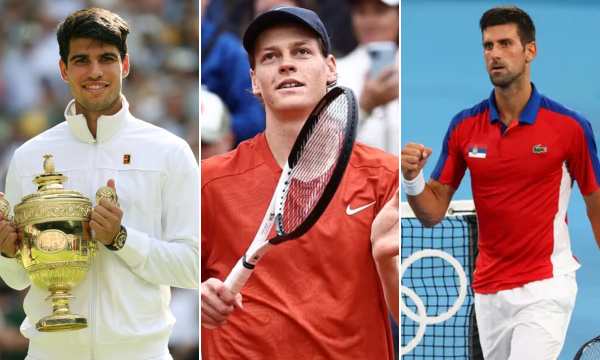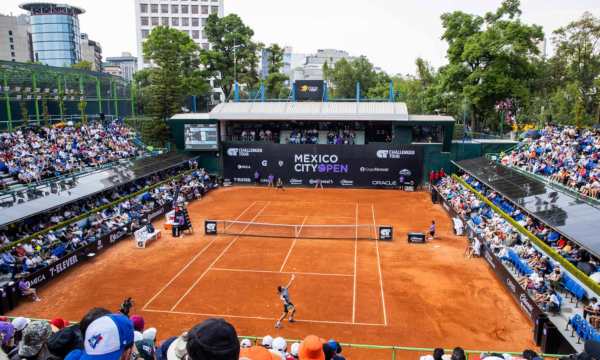Learn All About the ATP: The Elite of Men’s Tennis in 2025
Discover how the ATP has transformed men’s tennis into a professional and highly competitive global circuit.
Anúncios
Today, the Association of Tennis Professionals represents the pinnacle of men’s tennis, with tournaments that captivate millions of fans around the world.
For those passionate about the sport, understanding how this circuit works is essential to appreciate each match, each ranking, and each player’s achievements.
In 2025, the circuit brings exciting new features while maintaining the traditions that make tennis one of the most elegant and challenging sports on the planet.
What is the ATP and How is it Structured?
The ATP (Association of Tennis Professionals) is the governing body of the professional men’s tennis circuit worldwide.
Founded by players for players, it revolutionized the sport by giving athletes a voice in important decisions regarding professional tennis.
This organization establishes the rules, manages the calendar, and oversees the distribution of points that determine the world ranking.
The organizational structure is divided into three fundamental pillars that work together to ensure the success of the professional circuit.
- Players’ Council: Represents the interests of players in different categories and regions of the world.
- Tournament Council: Advocates for the interests of official events that make up the annual calendar.
- Board of Directors: Combines representatives from both sides to make final decisions.
The association’s tournaments are hierarchically categorized:
- ATP Masters 1000: 9 premium tournaments with a maximum score of 1000 points.
- ATP 500: 13 intermediate-level events.
- ATP 250: Over 40 smaller but important tournaments.
- Grand Slams: Although technically not ATP tournaments, they are the most prestigious events.
- ATP Finals: The elite tournament that brings together the top 8 of the season.
- ATP Challenger Tour: Secondary circuit for rising players.
In 2025, the Association of Tennis Professionals consolidated its digital presence with immersive broadcasts and interactive experiences for fans, featuring augmented reality, real-time statistics, and player perspectives during matches.
Understanding the Ranking System
The association’s ranking system is the compass that guides the world of professional men’s tennis, determining who the best players are.
Based on a 52-week cycle, the ranking considers the results obtained by players in official circuit tournaments.
Each player accumulates points based on their performance, and these points are valid for exactly one year.
The scoring varies significantly depending on the tournament category and the stage reached by the player.
A Grand Slam title earns an impressive 2000 points, while a Masters 1000 guarantees 1000 points to the champion.
ATP 500 and ATP 250 tournaments distribute points proportional to their category. The big news in 2025 is the “ATP Performance Metrics” system, which complements the traditional ranking.
In addition to victory points, players receive micro scores in categories such as serve power, return accuracy, and physical endurance.
This ranking is not just a matter of prestige – it determines whether a player directly enters the main draws of tournaments.
The Best Tennis Players in 2025
The association’s circuit in 2025 features a fascinating mix of still-dominant veterans and young talents who have cemented their place among the elite of world tennis.
The new generation has finally claimed its spot at the top of the ranking, although some legends continue to show impressive longevity and fierce competitiveness.
The current top 10 includes:
- Carlos Alcaraz (ESP): Consolidated his complete game with greater serve consistency.
- Jannik Sinner (ITA): Found the perfect balance between power and patience.
- Novak Djokovic (SRB): At 38, still surprises with his flexibility and mentality.
- Holger Rune (DEN): Transformed his temperament into impressive mental strength.
- Jack Draper (GBR): The new British sensation with a devastating serve.
- Felix Auger-Aliassime (CAN): Finally converted his potential into consistent achievements.
- Lorenzo Musetti (ITA): His one-handed backhand is considered the most elegant on the circuit.
- Ben Shelton (USA): The left-handed American who revolutionized the serve with innovative technique.
- Alexander Zverev (GER): Remains relevant with smart adaptations to his game.
- Sebastian Korda (USA): Complete and strategic, represents the resurgence of American tennis.
The 2025 circuit is characterized by faster and more physical tennis, but still values tactical intelligence.
The new talents bring varied styles that enrich the sport and create exciting rivalries that promise to define the next decade of men’s tennis.

Alcaraz-Sinner-and-Djokovic-(Source-Google)
Learn More About the Major ATP Tournaments
The ATP Masters 1000 tournaments represent the pinnacle of the regular calendar just below the Grand Slams in prestige and points.
These nine premium events take place in iconic settings around the world, invariably bringing together the best players.
In 2025, the Masters series gained even more relevance with record prizes and new competition formats.
Indian Wells and Miami form the prestigious “Sunshine Double” on hard courts in the USA during March.
The Monte Carlo Masters kicks off the European clay season in April with its stunning Mediterranean setting.
Madrid and Rome complete the clay trilogy in May, preparing players for Roland Garros, each with their own altitude and playing condition peculiarities.
The 2025 Masters 1000 calendar:
- Toronto/Montreal (Canada): Takes place on hard courts in August, alternating between cities.
- Cincinnati (USA): One of the oldest tournaments, held in August on hard courts.
- Shanghai (China): The giant Asian tournament held on hard courts in October.
- Paris-Bercy (France): The last Masters takes place in November on indoor hard courts.
The major innovation in 2025 was the introduction of the “ATP Masters Cup” – a mini-tournament among the champions of the nine Masters of the year.
This special competition occurs immediately before the ATP Finals and offers a significant bonus of points for the winner, making the ranking race even more exciting.
ATP Finals: Format and Importance of the Tournament
The ATP Finals represents the pinnacle of the regular season in men’s tennis, bringing together only the top eight players in the world in a unique competition format.
Traditionally held in November, this prestigious event closes the calendar with matches of the highest technical and tactical level.
The 2025 tournament marks the fourth consecutive year in Turin, Italy, after a long stay in London.
Unlike other circuit tournaments, the ATP Finals uses a group system followed by knockout rounds.
The eight participants are divided into two groups of four, where everyone plays against everyone in their group.
The top two from each group advance to the semifinals in a knockout format, culminating in the grand final.
Characteristics that make the ATP Finals special:
- Record prize money: Offers the highest prize per win in the entire circuit.
- High points: Each win in the group stage is worth 200 points.
- Undefeated champion: A player who wins all matches can accumulate 1500 points.
- Controlled indoor environment: Fast courts in ideal conditions for the spectacle.
This tournament not only represents the end of the season but also a crucial moment to define the final ranking of the year.
ATP Challenger Tour: The Path to Stardom
The ATP Challenger Tour serves as the gateway to the main circuit, offering vital opportunities for developing players and veterans seeking to regain their ranking.
This secondary circuit is essential for the ecosystem of professional tennis, forming a necessary bridge between the entry level (ITF World Tennis Tour) and the elite of the sport.
In 2025, the Challenger Tour was significantly expanded to 185 global tournaments, representing a 15% growth in five years.
The more balanced geographical distribution allows players from all continents to access quality competitions without constant intercontinental travel.
Several current champions of the main circuit forged their careers on the Challenger Tour.
Carlos Alcaraz won his first professional titles in this circuit before exploding to stardom. Jannik Sinner and Ben Shelton also used the Challengers as an essential springboard for their meteoric rises.

ATP-Challenger-Tour-on-the-court-in-Mexico-(Source-Google)
The New Rules Shaking Up the ATP in 2025
The Association of Tennis Professionals surprised the tennis world in 2025 with a series of regulatory innovations aimed at balancing tradition and modernity in the sport.
These changes aim to speed up the pace of the game, increase fan engagement, and preserve athletes’ health during the long season.
Key regulatory innovations in 2025:
- Single serve rule: In specific tournaments, players have only one serve.
- Coaching allowed: Coaches can guide players during matches via an approved device.
- Reduced sets: Format of sets up to 4 games in selected tournaments.
- Tie-break decision: Fifth set decided in a super tie-break (up to 10 points).
- Reduced time: From 25 to 20 seconds between points on fast courts.
The new “ATP Player Welfare Initiative” implemented mandatory rest periods for athletes who play more than 70 matches per season.
Additionally, players must take two full weeks off every four months of competition. The doubles format also underwent renovation, with shorter sets and no-ad scoring (no advantage) in all matches.
These changes reflect the continuous evolution of tennis under the administration of the Association of Tennis Professionals, which seeks to keep the sport relevant for new generations while preserving the core elements that made it so special.
The Preparation Secrets of Champions
The current Association of Tennis Professionals circuit demands an unprecedented level of physical and mental preparation in the history of tennis.
Elite players develop meticulously personalized training programs that combine cutting-edge science and traditional methods.
The grueling season, which spans continents and varied surfaces, requires strategic planning that goes far beyond hours on the court.
Data analysis has completely transformed the preparation of circuit players. Each top 100 player now has statisticians who analyze their own and their opponents’ playing patterns.
Sensors placed on rackets capture information about spin, speed, and impact point on each shot during training and official matches.
In 2025, each Masters 1000 and Grand Slam tournament has a team of sports psychologists available for players.
Mindfulness and meditation techniques have become as important as physical training for many elite athletes.
Curiosities Every Fan Should Know
Beyond results and rankings, professional men’s tennis carries extraordinary stories and peculiar traditions that connect generations.
The number 1 ranking trophy weighs an impressive 30 kilograms, making it one of the heaviest in the sports world.
The record for the longest match in the history of the Association of Tennis Professionals belongs to Isner and Mahut, with an incredible 11 hours and 5 minutes at Wimbledon 2010.
Interesting facts about the circuit:
- Different balls: Each tournament uses specific models that vary significantly in weight and speed.
- Maximum serve speed: The official record is 263 km/h, achieved by Sam Groth in 2012.
- Dress code: Wimbledon still requires predominantly white clothing, a tradition since 1877.
- Unique terminology: “Bagel” (6-0 set) and “Breadstick” (6-1 set) are official circuit slang.
- Court requirements: The official net height is 91.4 cm at the sides and 88.9 cm at the center.
The association introduced a pioneering sustainability program in 2025, committing to making all Masters 1000 events carbon-neutral by 2028.
Interestingly, chair umpires on the circuit must undergo annual hearing tests to ensure their ability to discern subtle net touches.
For true enthusiasts, these curiosities transform the experience of watching Association of Tennis Professionals tennis, revealing the complexity and richness of details that make this sport a global passion.
Conclusion
The ATP has demonstrated remarkable adaptability to changes in consumer preferences for sports.
The balance between preserving traditions and embracing innovations has been the secret to the circuit’s longevity and continuous growth.
For those who follow tennis, the association offers a continuous narrative of overcoming, rivalries, and moments of athletic brilliance.
Each point played on courts around the world carries stories of dedication, hard work, and dreams.
As we look to the future of men’s tennis, one thing is certain: the ATP will continue to be the stage where the greatest talents in the sport write their stories of glory.
FAQ
How can a young player enter the Association of Tennis Professionals circuit?
What is the difference between ATP and ITF?
Is the ATP Finals more important than a Grand Slam?
Why are the Grand Slams not Association of Tennis Professionals tournaments?
 WTA Tennis: A Complete Guide to the Current Women’s Circuit
WTA Tennis: A Complete Guide to the Current Women’s Circuit
WTA: the circuit that revolutionized women’s tennis worldwide! Anúncios This professional circuit has transformed athletes into global icons and redefined standards in women’s sports. Each season, […]
Keep reading Serena Williams: The Journey and Records of the Tennis Legend
Serena Williams: The Journey and Records of the Tennis Legend
Serena Williams transformed women’s tennis with a powerful playing style that we had never witnessed on professional courts. Anúncios More than an extraordinary athlete, she became […]
Keep reading What Makes Novak Djokovic a Genius on the Court?
What Makes Novak Djokovic a Genius on the Court?
Novak Djokovic has transformed modern tennis with a rarely seen combination of natural talent and methodical discipline. Anúncios Have you ever wondered how a boy who […]
Keep reading